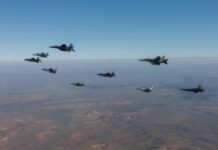When people think about the U.S.-ROK alliance, they often envision the Korean Peninsula: joint ground drills, combined air exercises, and the perennial challenge of deterring a North Korean invasion. But the next chapter of this alliance is unfolding at sea. With the U.S. Navy stretched across multiple theaters—from the Mediterranean to the South China Sea—South Korea’s maritime ambitions are no longer a peripheral concern. They are a strategic asset. (From the Center for International Maritime Security.)
South Korea is undertaking a deliberate and ambitious transformation of its navy into a blue water force capable of regional power projection. This evolution is not simply about prestige or symbolism. It is a calculated move rooted in geostrategic necessity. As tensions rise in the Taiwan Strait and Chinese naval power expands across the first and second island chains, Washington should see Seoul’s naval modernization not as redundant or overlapping, but as a critical force multiplier.
This is especially relevant in the Yellow Sea, where a better-integrated U.S.-ROK naval posture could significantly enhance sea denial capabilities South Korea’s geographic proximity to China’s northern coastline presents a strategic opportunity to constrain the PLA Navy’s North Sea Fleet, which is headquartered in Qingdao and tasked with defending China’s most vulnerable maritime approaches. By jointly developing anti-access/area-denial (A2/AD) strategies focused on the Yellow Sea, the alliance could effectively impose strategic costs on China’s northern naval operations and blunt its access to the first island chain.
The Rise of South Korea’s Blue-Water Navy
The Republic of Korea Navy (ROKN) has traditionally played a coastal defense role focused on deterring North Korean provocations in the Yellow Sea and the Sea of Japan. But over the past two decades, a combination of economic capability, strategic awareness, and domestic political will has pushed Seoul to rethink its naval posture.
The evolution began with the KDX series of destroyers—KDX-I, KDX-II, and the 10,000-ton KDX-III (Sejong Daewang-class guided-missile destroyers)—equipped with Aegis combat systems, long-range anti-air missiles, and sophisticated sensors. These ships have given the ROKN capabilities far beyond the littorals. More recently, the KDDX program—slated to deploy stealthier, AI-integrated destroyers by the early 2030s—signals an even greater leap in warfighting capability.
Beneath the surface, South Korea is producing the Jangbogo-III class submarines, featuring Air-Independent Propulsion (AIP), advanced sonar, and the ability to launch indigenous cruise missiles. These quiet, long-endurance platforms are designed for regional influence, extending beyond traditional deterrence roles.
Then there is the controversial CVX program, which remains stalled due to political debate and lack of budgetary support. Initially conceived as a 30,000-ton light aircraft carrier to deploy short take-off and vertical landing (STOVL) aircraft like the F-35B, CVX was intended to give Seoul the ability to project power far from its shores. Critics within Korea have questioned its cost and doctrinal utility, and recent administrations have deprioritized the project in favor of counter-North Korean capabilities. Still, the strategic rationale behind the program reflects Seoul’s growing maritime confidence and its long-term ambition to contribute more meaningfully to regional security.
Strategic Drivers of Naval Expansion
South Korea’s shift toward a maritime posture is driven by three primary strategic imperatives. First, North Korea’s expanding maritime threat has grown increasingly sophisticated. Pyongyang’s development of submarine-launched ballistic missiles (SLBMs), its recent experimentation with unmanned maritime strike systems, and its emphasis on asymmetric naval tactics all underscore the need for a robust undersea deterrent. A capable Republic of Korea Navy (ROKN) is essential not only for defending territorial waters, but also for denying North Korea sanctuary beneath the surface. It is worth noting that the Atlantic Council’s recent report, “A Rising Nuclear Double-Threat in East Asia: Insights from our Guardian Tiger I and II Tabletop Exercises,” demonstrates how a naval skirmish in the Yellow Sea between North and South Korea could plausibly escalate—by 2030—into a dual contingency, triggering simultaneous crises on the Korean Peninsula and in the Taiwan Strait.
This scenario underscores the critical importance of effective naval deterrence and denial capabilities against North Korean maritime threats. It also implies a wider operational logic: improved U.S.-ROK naval integration could serve not only to deter North Korea but also to enhance regional readiness for broader contingencies involving both China and Russia. As Russia’s Pacific Fleet increases its operational tempo in the Sea of Japan—particularly near Vladivostok, its key naval hub—a forward-deployed and interoperable ROK Navy can play a vital role in surveillance, anti-submarine warfare, and presence operations. Greater alliance coordination in these waters would enable the U.S. Navy to retain pressure on Russian forces without further stretching its already overtasked carrier and submarine assets.
Second, South Korea’s economic vulnerability via its sea lines of communication (SLOCs) compels a more active naval presence. As a global trading nation heavily dependent on maritime imports—particularly energy—South Korea is acutely exposed to regional disruptions in maritime routes. Any conflict in the South China Sea or Taiwan Strait would pose serious risks to these lifelines, and protecting them requires more than the reach of coast guard patrols.
Third, shifts in U.S. force posture are creating strategic space—and necessity—for capable allies to assume greater responsibilities. As the United States confronts the demands of great power competition and redistributes its naval resources, a strengthened and regionally integrated South Korean navy can help relieve pressure by taking on critical missions in Northeast Asia, thereby enabling U.S. forces to concentrate on high-end deterrence operations elsewhere.
Naval Power and the U.S.-ROK Alliance
Historically, maritime coordination has not been the centerpiece of the U.S.-ROK alliance. While Combined Forces Command (CFC) has focused primarily on land and air integration, naval cooperation has traditionally been limited to joint drills and port visits—though this has begun to evolve in recent years with increased trilateral and ASW cooperation. But this is beginning to change.
The U.S. Indo-Pacific Strategy explicitly calls for networked security architecture, encouraging allied navies to coordinate maritime domain awareness (MDA), logistics, ISR (Intelligence, Surveillance, Reconnaissance), and undersea capabilities. South Korea has begun participating more actively in multilateral exercises like RIMPAC and Pacific Vanguard. Trilateral maritime exercises with the U.S. and Japan have also become more routine, despite political sensitivities in Seoul. However, these efforts remain fragmented and largely ad hoc, lacking the continuity and command structure necessary for sustained strategic impact. As the alliance faces increasingly complex, multi-domain maritime challenges—ranging from North Korean subsurface threats to regional contingencies involving China and Russia—the case for deeper institutional coordination becomes compelling. One promising pathway is the establishment of a Combined Maritime Command: a mechanism that could integrate planning, synchronize task force deployments, and enable real-time information fusion.
Unlike the existing ground-focused Combined Forces Command, such a structure would reflect the evolving character of naval warfare and anchor maritime cooperation in a permanent, mission-ready framework. Additionally, both Washington and Seoul are exploring data sharing and co-development in AI-enabled maritime systems. Seoul’s defense sector, spearheaded by companies like Hanwha Ocean and LIG Nex1, has the technological foundation to contribute to next-generation maritime warfare, from unmanned surface vehicles (USVs) to AI-supported sonar systems.
Policy Recommendations for Washington
Supporting South Korea’s naval rise requires more than rhetorical endorsement; it demands a set of deliberate and concrete policy actions by Washington. First, the United States should identify opportunities for joint research and development as well as limited technology transfer in key areas such as undersea warfare, autonomous maritime systems, and AI-enhanced command and control. Co-developing these capabilities with a trusted ally like South Korea would not only bolster interoperability but also strengthen Seoul’s defense industrial base.
Second, Washington should work with Seoul to institutionalize robust maritime intelligence-sharing mechanisms. Drawing inspiration from frameworks like the Five Eyes, a Northeast Asian naval intelligence partnership could significantly enhance regional maritime domain awareness and sharpen tactical decision-making across allied navies.
Third, joint training and exercises should be expanded beyond the waters near the Korean Peninsula. South Korea should be regularly included in U.S.-led naval operations throughout the second island chain, including in the Philippine Sea, South China Sea, and broader Western Pacific. Such participation would normalize long-range ROKN deployments and allow the U.S. Navy to maintain presence across a wider expanse without overstretching its own assets.
Finally, the alliance should explore the creation of a combined maritime command structure that parallels the existing Combined Forces Command on land. Although politically sensitive—particularly in light of ongoing discussions around OPCON transfer—such a structure would better reflect the realities of modern maritime warfare and the shared regional burdens that come with it. More concretely, a Combined Maritime Command could offer a standing bilateral mechanism for coordinating patrol areas, real-time sensor fusion, and logistics prepositioning. It would also allow for joint operational planning in response to overlapping threats from North Korea, China, and Russia—threats which increasingly defy traditional geographic boundaries. A permanent command structure would facilitate the joint execution of distributed maritime operations (DMO) and enable more dynamic force employment (DFE)within the alliance, aligning with current U.S. Navy doctrinal trends. However, such an initiative would need to overcome several significant hurdles.
Domestically, South Korea’s evolving but cautious posture on OPCON transfer and joint command structures could stir political controversy, especially amid ongoing debates over military sovereignty. Bureaucratically, the absence of a tradition of joint maritime commands within South Korea’s naval doctrine would necessitate a paradigm shift in command culture and planning processes. Operationally, issues such as legal authorities, peacetime rules of engagement, and joint logistics would need to be ironed out. To navigate these complexities, a phased approach may be prudent—starting with joint maritime planning groups, mission-specific task forces, and gradually evolving toward a permanent Combined Maritime Command as trust, interoperability, and strategic alignment mature.
Why the U.S. Needs a Strong South Korean Navy
Critics may ask whether the U.S. really needs another blue-water ally when it already works closely with Japan and Australia. But the answer lies in geography, capability specialization, and political flexibility. Japan’s navy is world-class in terms of technology and training, fielding advanced destroyers, submarines, and even F-35B-capable carriers. Yet it remains politically constrained by constitutional limitations—most notably Article 9—and cautious public sentiment that continues to shape the scope of Japan’s overseas military activities. Even after the 2015 legislative reforms and revised U.S.-Japan defense guidelines, Tokyo’s ability to engage in high-intensity or preemptive operations remains narrowly defined and heavily restricted. Australia, meanwhile, boasts potent naval assets but is geographically removed from key Northeast Asian flashpoints. South Korea, by contrast, offers an increasingly capable and politically willing partner, situated at the frontline of regional hotspots: the Yellow Sea, the East China Sea, and even the Taiwan Strait. Its navy is not only modernizing rapidly but is also unconstrained by many of the domestic limitations that hinder its allies.
Moreover, South Korea brings industrial capacity to the table. Its shipbuilding firms are already among the best globally. If the U.S. seeks to build a coalition-based maritime deterrent in the Indo-Pacific, Seoul is indispensable—not just as a consumer of U.S. systems, but as a producer of regionally relevant platforms.
At a time when the U.S. Navy is confronting widening capability gaps, the need for trusted, interoperable allies is more pressing than ever. Chronic delays in shipbuilding—exacerbated by industrial base constraints, workforce shortages, and budget uncertainty—have slowed the delivery of key platforms like the next-generation DDG(X) destroyers and the Columbia-class ballistic missile submarines. Meanwhile, maintenance backlogs have reduced the operational availability of existing surface combatants and submarines, straining fleet readiness. Carrier strike groups are being over-deployed to meet simultaneous demands in the Middle East, Europe, and the Indo-Pacific, often without sufficient dwell time, degrading both materiel and personnel endurance. Amphibious readiness is also under pressure, with debate continuing over the future of the LPD and LHA programs. In this environment, having a capable ally like South Korea—with Aegis-equipped destroyers, modern submarines, and ambitions for its own light aircraft carrier—is not a luxury or symbolic gesture. It is a strategic necessity. Seoul’s platforms are increasingly interoperable with U.S. systems, and their regional positioning allows the ROK Navy to help secure key maritime corridors and reinforce deterrence at precisely the time and place where U.S. naval bandwidth is most strained.
Conclusion: A Maritime Alliance for the Indo-Pacific Era
The U.S.-ROK alliance was forged in ground combat but will be tested in maritime competition. As the Indo-Pacific becomes the primary arena of strategic contestation in the 21st century, navies—not just armies—will shape deterrence outcomes.
Washington must therefore adapt its mindset. Supporting South Korea’s naval expansion is not about shifting the burden, but about co-creating a more resilient, integrated, and capable maritime network. Seoul is rising to meet the challenge. The U.S. should meet it alongside.
From undersea sensors to carrier decks, the next phase of alliance credibility will be forged at sea. It is time to set sail together.
*Dr. Ju Hyung Kim, President of the Security Management Institute—a defense think tank affiliated with the South Korean National Assembly—led a study commissioned by the South Korean Navy titled ‘Regional Naval Modernization Trends and Future Directions for the ROK Navy’s Core Capabilities.’



